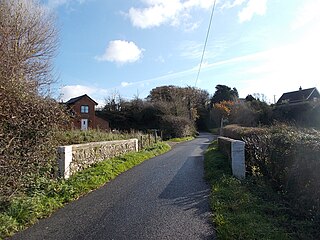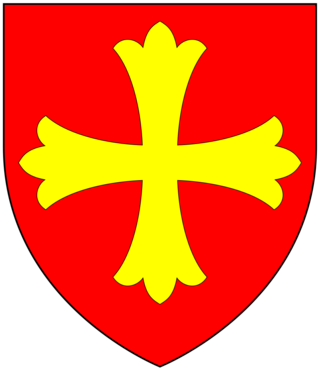
John I Lisle, 1st Baron Lisle of Wootton (died 1304), from Wootton in the Isle of Wight, was an English landowner, soldier and administrator who from 1299 to 1302 was summoned to Parliament as a baron. [1]

John I Lisle, 1st Baron Lisle of Wootton (died 1304), from Wootton in the Isle of Wight, was an English landowner, soldier and administrator who from 1299 to 1302 was summoned to Parliament as a baron. [1]
His family, whose name appears in French as de Lisle and in Latin as de Insula, had been landowners and administrators on the Isle of Wight, then part of Hampshire, since the time of his great-great-grandfather Jordan Lisle. Born about 1240, he was the son and heir of William Lisle, who died about 1252. [1]
In 1267 he was governor of Carisbrooke Castle on the island[ citation needed ] but then spent many years fighting outside England, first in Wales in 1277 and again in 1282, when he was knighted, and then in France in 1295. There he was in the English garrison of Blaye on the Gironde, receiving a royal protection against tax on or seizure of his properties in England while serving abroad. By writs from 29 December 1299 to 13 September 1302 he was summoned to Parliament, so creating by later theory a hereditary barony. [1]
He died before 10 June 1304, holding considerable lands on both the island and the mainland: the grange of Briddlesford, the manor and fishery of Wootton and seven other manors on the island, plus the manor of Mansbridge and La Rugge Hall, together with Woodhouse and part of the forest of Chute, as well as the rights of the hereditary bailiff of the east walk of Chute, which had been settled on him on his marriage. These properties were valued at 79 pounds a year, [1] equivalent to about 80,000 pounds in 2022,
He married Nichola Columbiers, daughter of Michael Columbiers, of Chute, and their only known child was his heir John II Lisle. [1]

Harewood is a village, civil parish, former manor and ecclesiastical parish, in West Yorkshire, England, today in the metropolitan borough of the City of Leeds. The civil parish population at the 2011 census was 3,734.
The title of Baron Grey of Codnor is a title in the peerage of England.
Baron Lisle was a title which was created five times in the Peerage of England during the Middle Ages and Tudor period, and once in the Peerage of Ireland in the 18th century.

Charles Seely was a 19th-century industrialist and British Liberal Party politician, who served as a Member of Parliament (MP) for Lincoln from 1847 to 1848 and again from 1861 to 1885. He was one of the wealthiest industrialists of the Victorian era. He was an enthusiastic supporter of the Lincoln Mechanics' Institute.
Colonel Sir Charles Seely, 1st Baronet KGStJ, DL was a British industrialist and politician.

Several members of the Mortimer family were summoned to Parliament during the reign of Edward I, thereby making them hereditary barons in the Peerage of England. The most important family with this surname were the lords of Wigmore, a marcher lordship on the borders of Herefordshire and Shropshire with Wales, living at Wigmore Castle. The second Baron Mortimer of Wigmore was created Earl of March.

Roud is a hamlet on the Isle of Wight in southern England. According to the Post Office the population of the hamlet as at the 2011 census was included in the civil parish of Godshill.

Gerard II de Lisle, 1st Baron Lisle of Kingston Lisle was an English nobleman and soldier during King Edward III's campaigns in Scotland and France.

Lord Robert de Scales was a Knight Templar and loyal supporter of Edward I in his campaigns in Wales, Scotland, France and Flanders. In 1299 he, and his heirs, were bestowed with the title, Baron Scales and were henceforth known as 'Lord Scales'. He was a signatory of the Baron's Letter to Pope Boniface VIII in 1301.

Sir William Russell (1257–1311) was an English nobleman, knight, and holder of a moiety of the feudal barony of North Cadbury, Somerset, but spent most of his life engaged in the administration and defence of the Isle of Wight, where he obtained by marriage the manor of Yaverland. He served as constable of Carisbrooke Castle, and sat in parliament on two occasions, firstly as burgess for Great Bedwyn, Wiltshire, and then for the County of Southampton. As a baron his military service was called on several times by King Edward I Hammer of the Scots.

The Great Budbridge Manor is a manor house just south of Merstone, near Arreton, Isle of Wight, England. Fish ponds on the grounds appear medieval.
The Manor of Dyrham was a former manorial estate in the parish of Dyrham in South Gloucestershire, England.

Sir Henry de Bodrugan (c.1263–1308) was a Cornish landowner, knight and politician.

Robert de Lisle, 1st Baron Lisle was an English peer. He saw military service in Scotland, and fought at the Battle of Boroughbridge. After his wife's death, he joined the Franciscan order. He was the owner of the Lisle Psalter.

Simon de Montagu, 1st Baron Montagu was summoned to Parliament by writ and thereby became the 1st Baron Montagu. He was the ancestor of the great Montagu family, Earls of Salisbury.

Sir William Aton, sometimes called Baron Aton, of West Ayton in Yorkshire, was an English landowner, soldier and administrator who in 1371 was summoned to Parliament as a baron. His son died before him without children and any hereditary title lapsed.

Rougemont Castle in the manor of Harewood, in the parish of Weeton, North Yorkshire, England, is a ruined ringwork castle, now largely hidden within over-grown woodland, located to the south east of the village of Weeton, above the north bank of the River Wharfe, where the river turns in a right-angle at its confluence with Weeton Beck. No above-ground structure survives but the earthwork features remain visible of building platforms, ditch system, outer enclosure and fish ponds.
Sir John VI Lisle (1406-1471) was an English landowner, soldier, administrator, and politician from Wootton on the Isle of Wight.

William le Latimer, Lord of Corby and Billinges was an English noble. He was a crusader and served in English campaigns in Wales, Gascony, France and Scotland.